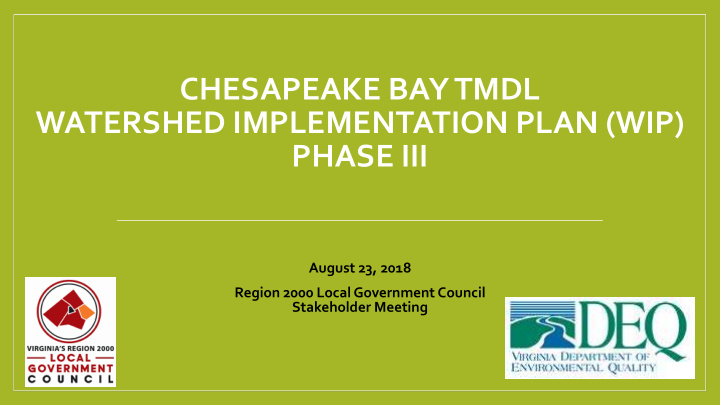



CHESAPEAKE BAY TMDL WATERSHED IMPLEMENTATION PLAN (WIP) PHASE III August 23, 2018 Region 2000 Local Government Council Stakeholder Meeting
Chesapeake Bay TMDL – 101 • In 2010 the Chesapeake Bay Total Maximum Daily Load (TMDL), or a pollutant load reduction plan for nitrogen (N), phosphorus (P), and sediment (TSS) to clean up the Chesapeakee Bay and the connected rivers, streams and creeks was established. Administered by EPA and agreed upon by NY, PA, WV, MD, DE, DC & VA. • TMDL - Suite of models to simulate 1) pollutant loads coming from the landscape and 2) transport and fate of pollutants throughout the watershed • Each state (and D.C.) is required to develop a Watershed Implementation Plan (WIP). Maps Source: DEQ
Watershed Implementation Plans (WIP) – 101 • The WIP presents how each sate (and D.C.) will meet the EPA-mandated nutrient reduction (TMDL) targets through a suite of Best Management Practices (BMPs), or programs, policies, and practices, that will collectively meet Bay watershed reduction, or load allocations, requirements. • WIP Objective – Have BMPs in place by 2025 to meet reduction targets • WIP Phases: • Phase I WIP (2010) – Focused on Agriculture , Wastewater and Stormwater • Phase II WIP (2012) – Used Phase I assumptions to meet 2017 and 2025 goals • Phase III WIP (2019) – Focus on sustained local strategies between 2018 - 2025; Data aggregated at SWCD or PDC level; Seek local data or strategies to ground-truth VA WIP submitted EPA
DEQ Statewide Phase WIP III Process • Focuses on engagement with stakeholders at the local level to provide the opportunity to review, evaluate, and refine local strategies – based on local knowledge, planning goals, programs and staff. • SWCDs PDCs Coordinate nutrient reductions from BMPS on Coordinate responses for unregulated urban, septic agricultural and most forest lands. and remaining forest nutrient reductions. DCR managed. DEQ managed.
Tools that will be used during the process • Draft Input Decks • LAPG Loads • LAPG BMPs • Potential BMP Funding Sources • Chesapeake Assessment Scenario Tool (CAST) • Online nitrogen, phosphorus and sediment load estimator tool. • Users specify a geographical area, and then select BMPs to apply on that area. • CAST builds the scenario and provides estimates of nitrogen, phosphorus, and sediment load reductions. CAST also provides the cost of a scenario, to allow users to select the most cost-effective practices to reduce pollutant loads.
Cast Online Tool Cast online tool Map of the Chesapeake Bay Watershed
Region 2000 Local Government Council (LGC) -Tasks PURPOSE Convene at least three stakeholder meetings. Stakeholders review and revise (as necessary) the BMP Input Deck that reflects the selected menu of BMPs that meet the Local Area Planning Goals (LAPGs) for the PDC-area unregulated urban and developed lands. Process does not include permitted lands ( MS4, CSO) . Develop descriptions of local co-benefits achieved through programmatic actions (e.g. economic development through enhanced outdoor recreation, flood control). Identify gaps in capacity and funding needs, local strategies or actions, and policy and programmatic recommendations (e.g. revisions to state code, regulation, or program funding). Hold a joint meeting with SWCD representatives, locality government staff, local stakeholders to discuss each Input Deck development effort. Timeline for this process: July 2 to December 14
LGC (PDC 11) Phase III WIP –Why Participate? • You care about your waterways • State will submit BMP data and strategies with or without local-are input • Without WIP local input future polices, funding decisions, regulations may not reflect local conditions or interest • Participation does not represent commitment to implementation • Implementing water quality BMPs can support other local goals
LGC (PDC 11) Phase III WIP - Initial Meeting Goals • Introduce Project • Fine tune WIP process/timeline • Identify additional stakeholders to participate • Conduct initial review of PDC 11 Input Deck • Begin compilation of local comments
LGC (PDC 11) Phase III WIP Process DEQ & LGC will work with local stakeholders to review Local Area Planning Goals (LAPGs) and Best Management Practices (BMPs) to accomplish reduction targets – urban, septic, remaining forest. Activity Purpose Date Stakeholder Meeting 1 August 23 rd Introduce Project & Propose Timeline Interim Report DEQ Report process, timeline, stakeholders September 15 th Review Input Deck (LAPGs & BMPs), identify September 20 th Stakeholder Meeting 2 potential changes, discuss strategies, local benefits & 1:00 pm – 3:00 pm capacity gaps to implement October 26 th Stakeholder Meeting 3 Continue Input Deck review, local comments, etc. 10:00 am – 12:00 pm Stakeholder Meeting 4 Review, Comment & Refine area LAPGs and BMPs for TBD Combined PDC/SWCD submittal to Commonwealth Final Report to DEQ December 15 th Present local LAPGs & BMPs for VA WIP to EPA
Identified Stakeholder Groups Who’s Missing?? • Local Governments • Local Colleges • Soil & Water Conservation Districts • Engineering Firms • Natural Resource Conservation Service • Izaak Walton League • James River Association • Extension Service • VA Dept of Environmental Quality • Central VA Land Conservancy • VA Dept of Health • CEDS Rivers & Community Initiative Council • VA Dept of Forestry • Citizens • VA Dept of Transportation • VA Dept Game & Inland Fisheries
PDC 11 Input Deck
PDC 11 Input Deck
PDC 11 Input Deck – Programmatic Examples
PDC 11 Phase III WIP –We Need Your Input Thank you! Kelly Hitchcock Planning & Development Local Government Council khitchcock @region2000.org 434-845-3491
Recommend
More recommend